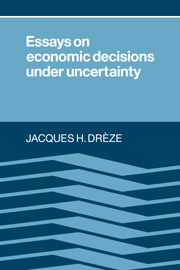Book contents
- Frontmatter
- Contents
- Acknowledgements
- Foreword
- I Decision-making under uncertainty: general theory
- II Markets and prices
- III Consumer decisions
- IV Producer decisions
- V Theory of the firm
- 14 Investment under private ownership: optimality, equilibrium and stability
- 15 Decision criteria for business firms
- 16 (Uncertainty and) the firm in general equilibrium theory
- IV Human capital and labour contracts
- VII Public decisions
- Index
15 - Decision criteria for business firms
Published online by Cambridge University Press: 01 October 2009
- Frontmatter
- Contents
- Acknowledgements
- Foreword
- I Decision-making under uncertainty: general theory
- II Markets and prices
- III Consumer decisions
- IV Producer decisions
- V Theory of the firm
- 14 Investment under private ownership: optimality, equilibrium and stability
- 15 Decision criteria for business firms
- 16 (Uncertainty and) the firm in general equilibrium theory
- IV Human capital and labour contracts
- VII Public decisions
- Index
Summary
Introduction and preview
Introduction
The economic theory of resource allocation was initially developed for a given environment, defined by (i) a set of commodities; (ii) a set of consumers, with their initial resources, consumption technology and preferences; (iii) a set of producers, with their initial resources and production technology. Actually, the environment is not given, but depends upon uncertain events. Research introduces new commodities and new technologies, resources are discovered or accidentally destroyed, consumer preferences are subject to unpredictable changes, the yield of production processes is affected by meteorological and random circumstances, and so on. An important conceptual clarification, introduced in the early fifties by Arrow (1953) and Savage (1954), consists in considering a set of alternative, mutually exclusive ‘states of the environment’, among which ‘nature’ will choose. This approach provides a more natural starting point for the economic theory of uncertainty than earlier formulations in terms of probability distributions for environmental characteristics or economic variables.1 In particular, individual decisions and overall resource allocation remain amenable, under the new approach, to a unified treatment, into which the deterministic theory fits as a special case.
Over the past 25 years, theoretical developments within the new framework have been conclusive on some issues, while other issues remain debated. Broadly speaking, the theories of consumer decisions, and of competitive equilibria with complete markets, have received lucid expositions, with successive contributions fitting neatly together.
- Type
- Chapter
- Information
- Essays on Economic Decisions under Uncertainty , pp. 298 - 320Publisher: Cambridge University PressPrint publication year: 1987
- 1
- Cited by

